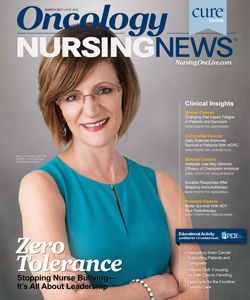The Shoe Is on the Other Foot When the Nurse Has Cancer
Patients seek our intimate connection to their experiences as fellow human beings, rather than diagnoses or clinical solutions.
Jennifer Wenzel, PhD, RN, CCM, FAAN

Cynda Rushton, PhD, RN, FAAN

Jennifer Wenzel, PhD, RN, CCM, FAAN, and Cynda Rushton, PhD, RN, FAAN
Jennifer Wenzel is an associate professor in the Department of Acute and Chronic Care at the Johns Hopkins School of Nursing, and Cynda Rushton is the Anne and George L. Bunting Professor of Clinical Ethics at the Johns Hopkins Berman Institute of Bioethics and the School of Nursing.
It's nearly impossible to truly know suffering you've never personally experienced. Nurses face this reality every day, as we treat individuals whose illnesses we are obviously intimate with but whose physical and emotional pain we may never know. This knowledge makes oncology nurse Lindsay Norris’s “I’m sorry” letter to her patients both a heartwarming read and a burning reminder for fellow caregivers—and those who teach them.1
“Dear every cancer patient I ever took care of, I’m sorry. I didn’t get it,” Norris begins. “This thought has been weighing heavy on my heart since my diagnosis.” She goes on to recount the many ways she could have been a better listener and a stronger advocate for these patients. Her newly discovered insights call for forgiveness. Lindsay Norris, now a patient with cancer, is not immune from the same diseases of her patients. Though we might appear invincible, and, at times, heroic, nurses are never more than human beings, sharing the same fears and injustices as everyone else. Norris is not the first nurse to be in this situation, after all. Cancer and other diseases do not care what your profession is.
What can we learn from Norris’s insights? Because we see people in some of their most vulnerable moments and in situations when their most basic human functions are under attack, it’s important for nurses to handle patient and family/care partner fragility with the utmost respect, humility, and empathy—in other words, to strive to be our best selves in the midst of suffering.
Again, that’s not to say nurses must be “perfect,” but we can strive for excellence by noticing and responding to patient and family vulnerabilities and preferences in all situations, even those we are unable to “fix.” We might not be able to “feel” our patients’ pain, but we can listen, offer our presence and competence, and always advocate on their behalf. Sound simple?
Norris tells us this is perhaps not so simple in practice.
The cancer experience has become so pervasive—“If not you, then someone you love”—yet we can lose that caring thread in what is a very busy, high-stress context. Cancer treatment is complex and frustrating, not only for the patient but for those providing care. Possibly, the only constants are uncertainty and fear.
One interesting part of Norris’s letter is how to respond to patients’ requests like, “What would you do if it were you?” There has been a longstanding norm in clinical practice that we should avoid such questions or deflect the answer away from our personal experience. And yet Norris reveals that there is more to this question than advice: Patients seek our intimate connection to their experience as fellow human beings, rather than diagnoses or clinical solutions. At the most basic level, they want human understanding and someone to be with them on this journey.
It’s tempting to see ourselves as the “experts.” But because we don’t always have THE answer, doesn’t mean we can’t offer patience, information, and understanding to patients needing it rather than wave away the worry with an empty reassurance. As Norris realizes, if you don’t know, say you don’t know, and then offer as much as you do know. This admission of frailty can be humbling and unnerving. But in the end, whose comfort matters most?
The American Nursing Association Code of Ethics begins by pointing to our obligation to respect patients and to care for them with compassion, but what does this really mean? Norris’s insights suggest that we need to let patients guide us in what they need. For instance, are we so focused on treatment protocols and outcomes that we lose the human connection and leave patients feeling like a set of numbers on a whole row of clipboards? Or, are we focused on the patient experience and the human aspects of caring for individuals in crisis? There’s no question that the latter takes more time. But listening and truly connecting can ultimately save time and avoid misunderstanding.
Being respectful requires us to challenge assumptions we might make about what patients need or how much information they want about their illness and prognosis. We should ask them at the very beginning of our care relationship and proceed from there.
What we really need to learn is how to make compassion a foundation for every encounter. It starts with remembering the central purpose for doing this work and being able to stand in the shoes of those we serve—or at least try them on—with humility, openness, and kindness. As clinicians and educators, we strive to teach and model such compassion every day. Isn’t education itself intended to be a shortcut for what experience might teach us?
As for the “I’m sorry” letter, what matters here will be the rest of the story. How will Norris put her newfound understanding to work once (we believe and hope) she is well enough to resume nursing? In a recent blog post, she indicated that she has been doing well and missed few days of work.2 She will have been given the gift of empathy with the plight of her patients. The shoes fit. The steps she takes in them can be an inspiration and a guide to nurses everywhere.
REFERENCES
1. Norris L. To every cancer patient I ever took care of: I’m sorry. I didn’t get it. The Huffington Post. https://tinyurl. com/jccac9h. November 23, 2016. Accessed February 17, 2016.
2. Norris L. mesh. undies. “Here Comes the Sun” [blog post] December 31, 2016. https://tinyurl.com/jueh9bj. Accessed February 23, 2017.

Innovative Program Reduces Nurse Turnover and Fosters Development
Published: September 12th 2024 | Updated: September 12th 2024The US Oncology Network (The Network) has developed one of the most comprehensive programs in the nation to support the professional development and retention of new oncology nurses.

